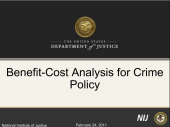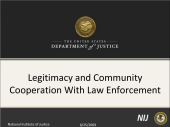Preventing Gun Violence: Understanding Law Enforcement Response and Improving Multi-disciplinary Partnerships for Peace
August 2016
Moderator
Howard Spivak, M.D., Deputy Director and Chief of Staff, NIJ
Panelists:
Charles Wellford Ph.D., Professor Emeritus, University of Maryland, College Park
David Hemenway, Ph.D., Director, Harvard Injury Control Research Center
Susan Sorenson, Ph.D., Professor, University of Pennsylvania
Hank Stawinski, Chief, Prince George’s County Police Department
This
Research for the Real World seminar explores common police practices for responding to gun violence and the extent to which they are contributing to reductions in violent incidents. The panel will also explore the role of multi-disciplinary partners such as the public health sector in reducing gun violence, and discuss promising practices for law enforcement partnerships to leverage complimentary violence reduction efforts. |

Watch the video
Transcript |
Violence Against American Indian and Alaska Native Women and Men: 2010 Findings from the National Intimate Partner and Sexual Violence Survey
June 2016
Moderator:Nancy Rodriguez, Ph.D., Director, National Institute of Justice
Presenter:André Rosay, Ph.D., University of Alaska Anchorage
Discussants:
-
Carrie Bettinger-Lopez, J.D., Advisor on Violence Against Women, Office of the Vice President
-
Joye Frost, Director, Office for Victims of Crime
-
Bea Hanson, Ph.D., Principal Deputy Director, Office on Violence Against Women
This seminar provides the first set of estimates from a national large-scale survey of violence against women and men who identified themselves as American Indian or Alaska Native using detailed behaviorally specific questions on psychological aggression, coercive control and entrapment, physical violence, stalking, and sexual violence. These results are expected to raise awareness and understanding of violence experienced by American Indian and Alaska Native people. |

Watch the video
Transcript |
Strengthening Law Enforcement-Community Relations
NIJ Research for the Real World Seminar
September 2015
Moderator: Karol V. Mason, Assistant Attorney General, Office of Justice Programs
Panelists:
- Sue Rahr, Executive Director, Washington State Criminal Justice Training Commission
- Anthony A. Braga, Professor of Evidence-Based Criminology, Rutgers University, and Senior Research Fellow in the Program in Criminal Justice Policy and Management at Harvard University
- Nola Joyce, Deputy Commissioner, Philadelphia Police Department
In this seminar, forward-looking figures in the law enforcement community discuss their contributions to the
Executive Session on Policing and Public Safety and examine how law enforcement can be improved through the adoption of community-minded policies.
|

Watch the Seminar
Read the transcript |
The "Real World" of Dating Violence in Adolescence and Young Adulthood: A Longitudinal Portrait
NIJ
Research for the Real World Seminar
September 2014
Professor Peggy Giordano, Ph.D., Bowling Green State University
In this seminar, Dr. Peggy Giordano of Bowling Green State University presents preliminary findings from the Toledo Adolescent Relationships Study (TARS), a thirteen-year longitudinal study examining the lives of young people transitioning into adulthood. In this study, Dr. Giordano led a team of researchers who performed five waves of structured in-home surveys paired with in-depth qualitative interviews with a subset of respondents who had experienced violence within the context of their dating relationships. The team found that there are numerous processes within early relationships that increase the risk of teen dating violence occurring, and a window on change — that is, factors associated with 'desistance' from this destructive pattern of behavior. Further, they found that when compared to adults, teens typically exhibit fewer gender-related differences in their patterns of violence; and the issues that trigger teen violence revolve more around anger than around control. |

Watch the seminar
Transcript of the seminar
Watch an interview with Dr. Giordano:
On YouTube
On NIJ.gov
Transcript of the interview |
Opening the Black Box of NIBIN
NIJ
Research for the Real World Seminar
July 2014
Professor William R. King, Sam Houston State University
John Risenhoover, NIBIN National Coordinator, Bureau of Alcohol, Tobacco and Firearms
Bill King discusses the operations of the National Integrated Ballistic Information Network (NIBIN), a program through which firearms examiners at state and local crime laboratories compare tool marks on fired bullets or cartridges found at a crime scene to digitized images of ballistic evidence in a nationwide database.
Dr. King headed up a team of NIJ-funded researchers from four universities (Sam Houston State University, Arizona State University, American University and the University of Cincinnati) that examined the value of NIBIN database "hits" in solving crimes in which firearms are used. He will talk about the team's findings and recommendations for improving the tactical value (using a NIBIN hit to link crimes that were not previously known to be related and, in turn, identify suspects) and the strategic value (helping law enforcement understand larger patterns of gun crime, including criminal activities of street gangs and drug cartels) of the NIBIN program.
Dr. King will be joined by John Risenhoover, NIBIN's national coordinator at the Bureau of Alcohol, Tobacco and Firearms, who will discuss how ATF has used the research findings in an effort to improve the efficiency and effectiveness of NIBIN. |

Watch the seminar
Transcript of the seminar |
Building Trust Inside and Out: Challenges Facing Police Leaders
NIJ
Research for the Real World Seminar
April 2014
Dr. Dennis Rosenbaum, Professor of Criminal Justice and Psychology at University of Illinois at Chicago
In the face of budget cuts, changing workforce demands, new varieties of crime and new technologies, how should police executives manage officers and other personnel and still ensure that organizational goals are being met?
Drawing on new data from a national sample,
Dr. Dennis Rosenbaum, Director of the Center for Research in Law and Justice at the University of Illinois, Chicago, discussed the latest findings from the NIJ-funded National Police Research Platform on the organizational dynamics of American police agencies. His discussion examined ways to measure agency performance, including the quality of leadership and supervision, personnel development and procedural fairness both inside and outside the organization. |

Watch the seminar
Transcript of the seminar |
Consequences of a Prison Record for Employment: How Do Race, Ethnicity & Gender Factor In?
NIJ
Research for the Real World Seminar
February 2014
Professor
Scott Decker
Arizona State University
Scientific studies have long documented the negative impact of a prison record on a person's ability to find employment. But what is the impact when gender and race/ethnicity are factored in? Also, most jobs are now advertised online — so how does this affect the ability of former prisoners to find a job?
Dr. Scott Decker and his colleagues have recently completed an in-depth examination of the roles of race, gender, and education in one of the greatest social challenges facing our nation today: employment for criminal offenders returning to the community. The findings — including the impact of having some post-high school education — may surprise you. Based on the results of this three-year study, Dr. Decker makes recommendations that could be critically important as decision- makers craft pre- and post-release policies and strategies to help more than 600,000 criminal offenders who return to the community every year, particularly in this increasingly online world.
We also recorded an interview with Dr. Decker. Watch on
YouTube or
NIJ.gov. |

Watch the seminar
Transcript of the seminar
Watch and interview with Dr. Decker:
On YouTube
On NIJ.gov
Transcript of the interview |
Why Is the United States the Most Homicidal Nation in the Affluent World?
NIJ
Research for the Real World Seminar
December 2013
Professor
Randolph Roth
Ohio State University Since World War II, the homicide rate in the U.S. has been three to ten times higher than in Canada, Western Europe, and Japan. This, however, has not always been the case. What caused the dramatic change? Dr. Roth discussed how and why rates of different kinds of homicide have varied across time and space over the past 450 years, including an examination of the murder of children by parents or caregivers, intimate partner violence, and homicides among unrelated adults. |

Watch the seminar
Transcript of the seminar |
Wrongful Convictions: The Latest Scientific Research & Implications for Law Enforcement
NIJ
Research for the Real World Seminar
March 2013
Jon Gould, Ph.D.
Professor of Law, Justice, and Society &
Director, Washington Institute for Public and International Affairs Research
American University
John R. Firman
Director, Research Division
International Association of Chiefs of Police (IACP)
What does science tell us about case factors that can lead to a wrongful conviction? Dr. Jon Gould of American University will discuss the findings of the first large-scale empirical study that has identified ten statistically significant factors that distinguish a wrongful conviction from a "near miss." (A "near miss" is a case in which an innocent defendant was acquitted or had charges dismissed before trial). Following Dr. Gould's presentation, Mr. John R. Firman from the IACP will talk about implications for law enforcement, including soon-to-be-released recommendations based on the IACP's 2012 summit on wrongful convictions. The summit brought together experts from throughout the justice system to talk about preventing wrongful arrests and convictions. |

Watch the seminar
Transcript of the seminar
Watch an interview with Dr. Gould:
On YouTube
On NIJ.gov
Transcript of the interview |
Changing the Behavior of Drug-Involved Offenders: Supervision That Works
NIJ
Research for the Real World Seminar
December 2012
Angela Hawken, Ph.D., Associate Professor of Economics and Policy Analysis, Pepperdine University, and
Mark Kleiman, Ph.D.Professor of Public Policy, University of California, Los Angeles
A small number of offenders who are heavily involved in drugs commit a large portion of the crime in this country. An evaluation of a "smart supervision" effort in Hawaii that uses swift and certain sanctioning showed that heavily involved drug offenders can indeed change their behavior when the supervision is properly implemented.
Drs. Angela Hawken and Mark Kleiman evaluated Hawaii's swift and certain supervision program, more commonly referred to as Hawaii HOPE. They discussed what they learned and how the principles of HOPE are being applied elsewhere.
They discussed, for example, the kinds of offenders who are now being supervised under HOPE-style programs in Hawaii and on the mainland. They also discussed the important unanswered research questions, such as: the psychological mechanisms that underlie the dramatic behavior changes, the minimum effective sanction, whether sanctions should escalate, and when revocation is appropriate. They also discussed the wider implications for juveniles, alcoholics, pretrial releases and prisoners, as well as the appropriate role of the federal government.
|

Watch the seminar
Transcript of the seminar |
The Neurobiology of Sexual Assault: Implications for First Responders in Law Enforcement, Prosecution, and Victim Advocacy
NIJ
Research for the Real World Seminar
December 2012
Rebecca Campbell, Ph.D., Professor of Psychology, Michigan State University
Dr. Campbell brings together research on the neurobiology of trauma and the criminal justice response to sexual assault. She explains the underlying neurobiology of traumatic events, its emotional and physical manifestation, and how these processes can impact the investigation and prosecution of sexual assaults. Real-world, practical implications are examined for first responders, such as law enforcement, nurses, prosecutors, and advocates. |

Watch the seminar
Transcript of the seminar
Watch an interview with Dr. Campbell:
On YouTube
On NIJ.gov
Transcript of the interview |
Reforming New Orleans' Criminal Justice System: The Role of Data and Research
NIJ
Research for the Real World Seminar
September 2012
Michael Jacobson, Ph.D., President and Director Vera Institute of Justice
With its criminal justice system in disarray following Hurricane Katrina, New Orleans invited the Vera Institute of Justice to examine the city's court and jail operations. For five years, Vera has been tracking arrest-to-first-appearance time, custodial arrests versus summonses, the granting of pretrial release, and many other decision-making points. Based on analysis of these data, Vera is making policy recommendations to assist with the implementation of new procedures and to ensure performance monitoring.
Like other jurisdictions, New Orleans had never collected court, jail, and other justice system data in ways that could inform policy development. Vera's work has demonstrated to key stakeholders that data capture and analysis can be critical. Learn more about these successes, the continuing challenges of replacing a jurisdiction's existing data systems, and how costs and other institutional issues will test the "acceptance" of critical criminal justice policies in the years to come.
NIJ also recorded an interview with Dr. Jacobson in which he addressed the following questions:
- What is the New Orleans Criminal Justice Leadership Alliance?
- How important is raw data in proposing criminal justice reforms in New Orleans?
- What are some of the new projects and initiatives that are currently being pursued?
- Are you optimistic for New Orleans' future?
|

Listen to the seminar (01:22:08)
Transcript of the seminar
Watch and Interview with Dr. Jacobson:
On YouTube
On NIJ.gov
Transcript of the interview |
Violent Repeat Victimization: Prospects and Challenges for Research and Practice
NIJ
Research for the Real World Seminar
April 2012
Janet L. Lauritsen, Professor of Criminology and Criminal Justice, University of Missouri-St. Louis
Research tells us that a relatively small fraction of individuals experience a large proportion of violent victimizations. Thus, focusing on reducing repeat victimization might have a large impact on total rates of violence. However, research also tells us that most violent crime victims do not experience more than one incident during a six-month or one-year time period. As a result, special policies to prevent repeat violence may not be cost-effective for most victims.
Dr. Lauritsen summarizes existing research on repeat violent victimization, both here in the United States and abroad. She provides new findings from the National Crime Victimization Survey about the potential impact that reducing repeat victimization might have on rates of violence in the U.S. She discusses possible factors that can be used to predict whether victimization is likely to be repeated and suggest how such information can inform policy and practice. She also discusses several factors, such as persistent exposure to offenders, that appear to be unique to repeat victimization and most relevant to developing effective policies and practices.
We also captured an interview with Dr. Lauritsen in which she discusses in three short segments:
- What is the National Crime Victimization Survey?
- Why is it so difficult to predict the likelihood of repeat victimization?
- How should victim service providers be evaluated?
|

Presentation (1:25:18)
Transcript of the presentation
Watch an interview with Dr. Lauritsen:
On YouTube
On NIJ.gov
Transcript of the interview |
Addiction, the Brain, and Evidence-Based Treatment
NIJ
Research for the Real World Seminar
March 2012
Redonna K. Chandler, Ph.D.Chief, Services Research Branch, Division of Epidemiology, Services, and Prevention Research, National Institute on Drug Abuse
The criminal justice system encounters and supervises a large number of drug abusing persons. Punishment alone is a futile and ineffective response to the problem of drug abuse. Addiction is a chronic brain disease with a strong genetic component that in most instances requires treatment. Involvement in the criminal justice system provides a unique opportunity to treat drug abuse disorders and related health conditions, thereby improving public health and safety. This presentation highlights the following: 1) the neuro-biology of addiction; 2) evidence-based principles of addiction treatment; and 3) research efforts underway at the National Institute on Drug Abuse to expand knowledge on effectively addressing drug abuse in the criminal justice system.
We also captured an interview with Dr. Chandler in which she discusses in three short segments:
- What is Addiction?
- The Relationship Between Drugs and Crime
- Drug Abuse as a Chronic Condition
|

Presentation (01:22:20)
Transcript of the presentation
Watch an interview with Dr. Chandler:
On YouTube
On NIJ.gov
Transcript of the interview |
Economical Crime Control: Perspectives from Both Sides of the Ledger
NIJ
Research for the Real World Seminar
December 2011
Phillip J. Cook, ITT/Sanford Professor of Public Policy, Professor of Economics and Sociology, Duke University
The surge in incarceration since 1980 has been fueled in part by the mistaken belief that the population can be divided neatly into "good guys" and "bad guys." In fact, crime rates are not determined by the number of at-large criminals, any more than farm production is determined by the number of farmers. Crime is a choice, a choice that is influenced by available opportunities as much as by character. This perspective, drawn from economic theory, supports a multi-faceted approach to crime control. Dr. Cook's presentation includes examples of effective programs and policies from both sides of the ledger — both people-changing, and opportunity-changing.
We were also able to capture an interview Dr. Cook in which he discusses in three short segments:
- The Normative Economistic Framework of Crime Control
- Crime Control Today: The Good Guy/Bad Guy Framework
- The Role of Private Action in Crime Reduction
|

Presentation (1:09:03)
Transcript of the presentation
Watch and interview with Dr. Cook:
On YouTube
On NIJ.gov
Transcript of the interview |
Going Home (or Not): How Residential Change Might Help Former Offenders Stay Out of Prison
Dr. David Kirk, Assistant Professor, University of Texas at Austin
October 2011
Dr. Kirk discusses how Hurricane Katrina affected ex-prisoners originally from New Orleans and their likelihood of returning to prison. Kirk also discussed potential strategies for fostering residential change among ex-prisoners, focusing specifically on parole residency policies and the provision of public housing vouchers.
We were also able to capture an interview Dr. Kirk in which he discusses in two short segments:
- Katrina as a Natural Experiment
- The Impact of Concentrated Re-entry
|

Presentation (1:25:31)
Transcript of the presentation
Watch an interview with Dr. Kirk:
On YouTube
On NIJ.gov
Transcript of the interview |
Try Again, Fail Again, Fail Better: Lessons from Community Courts
Greg Berman, Director, Center for Court Innovation
April 2011
Change doesn't come easy, particularly within an institution as large and complex as the criminal justice system. Greg Berman, Director of the Center for Court Innovation, offered lessons from several efforts to make reform stick in criminal justice settings. In particular, he focused on the development of community courts — experimental court projects that are attempting to reduce both crime and incarceration in dozens of cities across the U.S. and around the world. He also drew upon his recently-published book
Trial & Error in Criminal Justice Reform: Learning from Failure (Urban Institute Press). |

Presentation (1:12:36)
Transcript of the presentation
Watch and interview with Mr. Berman:
On YouTube
On NIJ.gov
Transcript of the interview |
Benefit-Cost Analysis for Crime Policy
Ms. Roseanna Ander, Executive Director, University of Chicago Crime Lab and Dr. Jens Ludwig, Director, University of Chicago Crime Lab
February 2011
How do we decide how to allocate criminal justice resources in a way that minimizes the social harms from both crime and policy efforts to control crime? How, for that matter, do we decide how much to spend on the criminal justice system and crime control generally, versus other pressing needs? These questions are at the heart of benefit-cost analysis.
Benefit-cost analyses begin with the crucial and often under-appreciated first step of successfully identifying the impact of a policy or program. Jens Ludwig and Roseanna Ander will explain the different options for identifying policy and program impacts, and discuss the challenges of attempts to monetize costs and benefits. For example, some of the most important costs and benefits of crime control efforts come from intangible aspects of well-being for which dollar values are not easily attached. |

Presentation (1:19:42)
Transcript of the presentation
Watch an interview with Dr. Ludwig:
On YouTube
On NIJ.gov
Transcript of the interview |
Children as Citizens: Engaging Adolescents in Research on Exposure to Violence
Dr. Felton Earls, Professor, Harvard University
January 2011
Since the adoption of the United Nations Convention on the Rights of the Child in 1989, great strides have been made in the areas of child protection and advocacy. However, the concept of children, and specifically adolescents, as functional and engaged citizens has also emerged. Through the guidance and recognition of adults, children can participate in deliberative democracy as legitimate and competent citizens. This citizenship, like that of adults, can be used to enrich and improve local communities by creating a sense of ownership and fairness. Dr. Earls presented research on child participation, child citizenship and their relationship to exposure to violence. The theories and practices guiding this research originated in the Project on Human Development in Chicago Neighborhoods and have continued to evolve in different settings around the world.
Dr. Earls was the Special Editor of the January 2011 ANNALS of the American Academy of Political and Social ScienceExit Notice, which focuses on conceptual, legal, and practical issues related to the realization of children as citizens. |

Presentation (1:13:14)
Transcript of the presentation
Watch an interview with Dr. Earls:
On YouTube
On NIJ.gov
Transcript of the interview |
Don't Jump the Shark: Understanding Deterrence and Legitimacy in the Architecture of Law Enforcement
Tracey Meares, Deputy Dean and Walton Hale Hamilton Professor of Law
November 2010
Deterrence theory dominates the American understanding of how to regulate criminal behavior but social psychologists' research shows that people comply for reasons that have nothing to do with fear of punishment; they have to do with values, fair procedures and how people connect with one another. Professor Meares discussed the relevance of social psychologists' emerging theory to legal theory and practice and how deterrence and emerging social psychology theories intertwine. She described her own research in urban police departments where she has attempted to integrate the findings from social psychology with deterrence and violence reduction strategies. |

Presentation (1:23:39)
Transcript of the presentation
Watch an interview with Tracey Meares:
On YouTube
On NIJ.gov
Transcript of Interview |
Mothers and Children Seeking Safety in the U.S.: A Study of International Child Abduction Cases Involving Domestic Violence
Dr. Jeffrey Edleson, University of Minnesota, Dr. Taryn Lindhorst, University of Washington, and Ms. Sudha Shetty, University of Minnesota
October 2010
Since the implementation of the Hague Convention on the Civil Aspects of International Child Abduction, thousands of abused women have faced complex litigation after seeking safety in the United States. Many have been court ordered to return their to the country from which they fled and often to their abusive partners custody. The presenters discussed the findings of an NIJ-funded study focusing on the experiences of women who as victims of domestic violence in another country, come to the U.S. in an effort to protect themselves and their children, and then face international child abduction procedures under the Hague Convention. |

Presentation (1:27:22)
Transcript of the presentation |
Police-on-Police Shootings and the Puzzle of Unconscious Racial Bias
Christopher Stone, Daniel and Florence Guggenheim Professor of the Practice of Criminal Justice, Harvard Kennedy School
June 2010
Professor Christopher Stone recently completed a study of police-on-police shootings as part of a task force he chaired in New York State. He reported on his findings and recommendations, exploring the role of race in policing decisions, methods to improve training and tactics to defuse police-on-police confrontations before they become fatal, and methods to improve the investigations of such shootings.
Read the report Reducing Inherent Danger: Report of the Task Force on Police-on-Police Shootings (pdf, 138 pages) Exit Notice from the New York State Task Force on Police-on-Police Shootings, chaired by Professor Stone. |

Presentation (1:11:57)
Transcript of the presentation |
Solutions in Corrections: Using Evidence-based Knowledge
Dr. Edward Latessa, University of Cincinnati
May 2010
Professor Ed Latessa describes how his team and he assessed more than 550 programs and saw the best and the worst. Professor Latessa shared his lessons learned and examples of states that are trying to use evidence-based knowledge to improve correctional programs. |

Presentation (1:17:17)
Transcript of the presentation
Watch an interview with Dr. Latessa:
On YouTube
On NIJ.gov |
Less Prison, More Police, Less Crime: How Criminology Can Save the States from Bankruptcy
Dr. Lawrence Sherman, University of Pennsylvania
April 2010
Professor Lawrence Sherman explains how policing can prevent far more crimes than prison per dollar spent. His analysis of the cost-effectiveness of prison compared to policing suggests that states can cut their total budgets for justice and reduce crime by reallocating their spending on crime: less prison, more police. |

Presentation (47:53)
Transcript of the presentation
Watch an interview with Dr. Sherman:
On YouTube
On NIJ.gov
Transcript of the interview |
Nurse-Family Partnerships: From Trials to International Replication
Dr. David Olds, University of Colorado
January 2010
David Olds, founder of the Nurse-Family Partnership Program, describes the programs long-term impact on mothers and babies who began participating in the program more than 19 years ago. The Nurse-Family Partnership maternal health program introduces vulnerable first-time parents to maternal and child health nurses. It allows nurses to deliver the support first-time moms need to have a healthy pregnancy, become knowledgeable and responsible parents, and provide their babies and later children and young adults with the best possible start in life. |

Presentation (55:35)
Transcript of the presentation
Watch an interview with Dr. Olds:
On NIJ.gov |
Legitimacy and Community Cooperation With Law Enforcement
Dr. Tom R. Tyler, New York University
August 2009
Tom R. Tyler, chair of the New York University psychology department, describes research on profiling and community policing. His research found that citizens of all races show greater respect for law enforcement when they believe officers are treating them fairly. Even citizens who experienced a negative outcome getting a traffic ticket, for example showed higher levels of respect for and cooperation with law enforcement as long as they believed they were not being singled out unfairly. |

Presentation (1:23:13)
Transcript of the presentation |
Crime Mapping and Hot Spots Policing
Dr. David Weisburd, Distinguished Professor of Administration of Justice at George Mason University
October 2009
David Weisburd, recipient of the 2010 Stockholm Prize in Criminology, explains research showing that intensified police patrols in high-crime hot spots can substantially decrease crime without causing it to rise in other areas. He explains the effectiveness of policing that concentrates prevention efforts at less than 5 percent of all street corners and addresses where more than 50 percent of urban crime occurs. The evidence suggests that crimes depend not just on criminals, but also on policing in key places. |

Interview (1:10:27)
Transcript
Learn more on the hot spots Web topic page. |
Civil Protection Order Enforcement
NIJ
Research for the Real World Seminar
October 2009
T.K. Logan, Professor, University of Kentucky
T.K. Logan discusses her study that looked at the impact of civil protective orders for domestic violence victims in five Kentucky jurisdictions. Civil protective orders, sometimes known as restraining orders, may cover various situations, such as ordering an assailant to avoid a victim's home and workplace or forbidding any contact with the victim, including by mail or telephone.
We also captured an interview with Professor Logan and Teri Faragher, M.S.W., C.S.W., Executive Director, Domestic Violence Prevention Board, Fayette County, Ky., in which they discuss in consequences, responses and costs and protective order effectiveness. |

Recorded presentation (01:20:40)
Transcript of the seminar
Watch an interview with Dr. Logan:
On YouTube
On NIJ.gov
Transcript of the interview |
Men Who Murder Their Families: What the Research Tells Us
Dr. Jackie Campbell, Johns Hopkins University
Dr. Richard Gelles, University of Pennsylvania,
David Adams, author of
Why Do They Kill? Men Who Murder Their Intimate Partners
June 2009
Experts discuss cases of domestic violence that escalate to homicide followed by suicide. Although the economy and unemployment are risk factors, prior domestic violence is by far the number one risk factor. The men usually display possessive, obsessive and jealous behavior, and they typically use guns to threaten and terrorize before they use them to kill. |

Presentation (1:30:08)
Transcript
Learn more about intimate partner violence on the Web topic page |
From the Academy to Retirement: A Journey Through the Policing Lifecycle
Dr. Dennis Rosenbaum, Professor of Criminal Justice and Psychology at University of Illinois at Chicago
December 2009
Professor Rosenbaum and a panel of colleagues discuss a study to demonstrate the feasibility of creating a foundation from which to launch studies about multiple aspects of policing using standardized definitions and measurement tools. Their goal is to advance knowledge about policing and translate data into evidence-based best practices that improve training, supervision and accountability systems. The effort is expected to produce a better understanding of what motivates police officers and makes them healthier, happier and more effective.
|

Presentation (1:17:27)
Transcript of the presentation
Learn more on the Web topic page Foundation for Policing Research |
